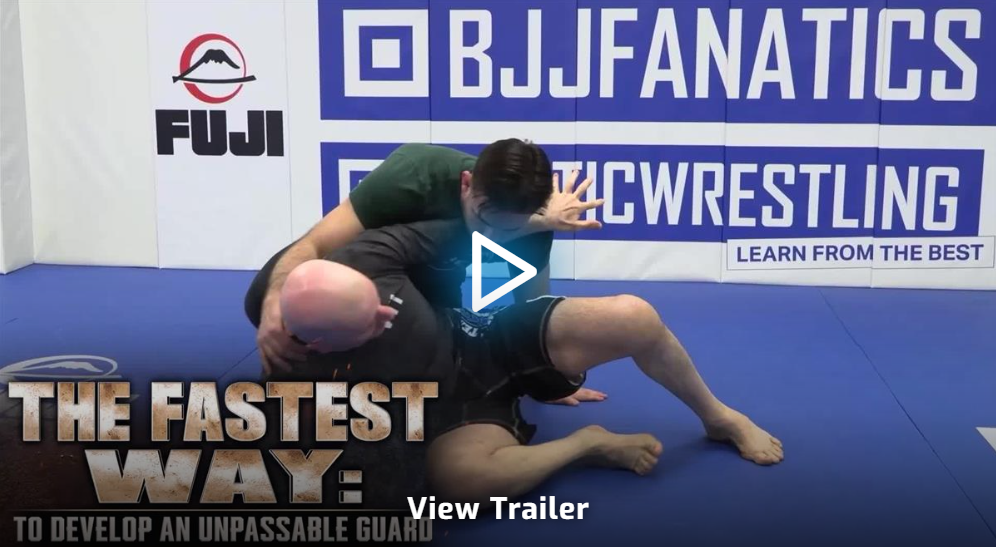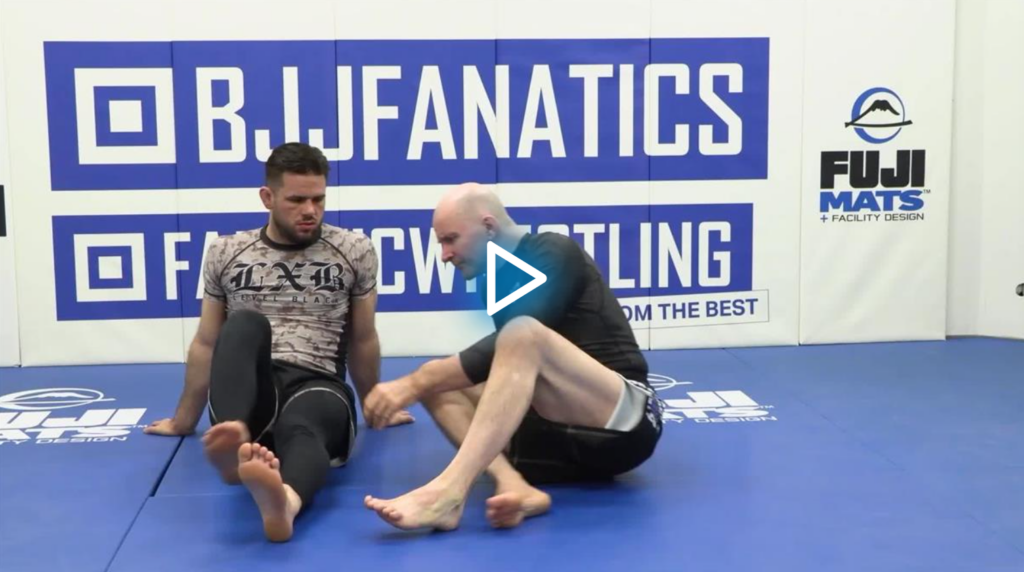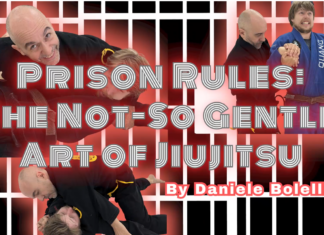The Unpassable Guard DVD By John Danaher. Is there really too much more that you want to know about this instructional?
Jokes aside, everyone who has managed to claw themselves up to the purple belt has realized how important a solid guard is. There is a huge difference between having a guard full of attacks and alone that people can’t get around. We’ll cover that in detail later, but can you guess which one is crucial to succeeding in Jiu-Jitsu?
So, when the undisputed best coach in the business offers a DVD instructional covering one of the key subjects of grappling that every person engaging in BJJ needs to know, you need to grab it as fast as humanly possible!
Key Takeaways
- 8-volume series with over 5 hours of high-level material;
- Focused on preventing different passes, rather than exploring different guards;
- All essential defensive guard body motions;
- Everything you need to become unpassable!
- BJJ World Expert Rating: 10 out of 10

GRAB THE UNPASSABLE GUARD DVD HERE!!!
What is the Key Role of The BJJ Guard?
Why do you play guard in Jiu-Jitsu? If your answer is anything except because it helps you keep the top person in a position that you can control, then you need to consider your priorities.
Ever since Ryan Hall came out with a DVD series on the defensive guard, more than 10 years ago, I got a bit confused. Everything I was taught about guard back in those days was hunting for sweeps and submissions. However, I never spend to much time trying to stay in any guard and keep the top person there.
To be honest, if you try to use a guard position to keep someone from moving away or passing your legs, you’ll quickly figure out that many fancy BJJ guards do not work in that sense. That means they do not work at all.
Unless you can keep your opponent where you want them, you’ll be unable to launch any of the attacks you want, leaving you in a position to defend a position you can’t really defend. That is where the Unpassable Guard DVD By John Danaher comes into the picture, covering guards as a means of preventing passing first and foremost. Read on to discover the details!
The John Danaher Effect
The explosion of John Danaher’s success as a coach led to a real revolution in Jiu-Jitsu. I am not just talking about the introduction of leg locks into the game as a system rather than a shortcut to get taps.
I am talking about the tectonic shift in thinking about the sport, both in terms of training it and coaching it. Danaher is living proof that there is no need to dismiss either Gi or No-Gi BJJ and is not afraid to challenge common dogmas in the sport by offering practical solutions over tradition-bound ones.
Danaher keeps on producing some of the best BJJ DVD instructional in the game, some of which are true gems in terms of covering subjects others brush off as inconsequential. One such subject is guard retention, the number one task you have as a guard player.
It is always fun to learn from someone who tries to find the most practical way of doing things as well as trying to factor in every possible variable that might prevent you from being successful with it. What’s not to love about the effect he has had on grappling?
Play-by-Play Review of the Unpassable Guard DVD By John Danaher
If you’ve ever seen a John Danaher DVD you know what to expect. You get 8 volumes of high-value grappling information, meticulously organized in chapters and following a very precise and easy-to-understand timeline. The only drawback is that to get the most out of the Unpassable Guard DVD By John Danaher you need to follow it volume by volume and that is a lot of material to cover:
Part 1 – Essential Body Movements
The introduction to the subject of guard retention starts in a very “traditional” way when ti comes to approaching the BJJ guard-body movement drills. While I am not a big fan of doing solo movements for BJJ, particularly for beginners, there is no denying that motion is what makes Jiu-Jitsu work.
John Danaher does a short intro on why movement is crucial, particularly for playing guard before covering the 12 key body movements you need to be successful at it. He also shares ideas on how to organize solo drilling to help you master the movements very quickly.
Part 2 – Understanding Guard Passing
The first volume of the Unpassable Guard DVD By John Danaher left me somewhat doubtful of what lies ahead, on account of the solo drills. However, I quickly changed my mind when I learned the approach Danaher has to guard retention – understanding what you’re fighting against.
Instead of focusing on how to make your guards strong, John demonstrates how guard passing works and leads us to focus on preventing common passing directions and threats using any guard, as opposed to exploring different guards one by one.
This portion covers the 5 stages of any guard pass, the 3 key danger zones of passing, and the stance and posture you need to take up to deal with them. He also covers the 3 crucial guard passing directions you’ll be facing, and the importance of keeping things simple.
Part 3 – Dealing with Distance Passing
Distance passing is the first passing direction addressed by Danaher in this instructional with a good reason – it is arguably the easiest to deal with as the person attacking you has to cover significant distance before succeeding in dealing with your legs.
The Toreando guard is the best representation of this type of passing. John offers several different leg retention methods, mostly by using the inside position to prevent distance passers from getting past your guard. He wraps up with several prop positions and frames to help you deal with the late stages of distance passing.
Part 4 – More Distance Passing Solutions
Consider the previous volume as the introduction to using your guard to deter different distance passing methods. This volume builds on it, with John providing even more elbow probing options and inside leg positions to open up attacking avenues while you are retaining your guard.
Danaher also demonstrates the importance of level changes when playing guard, which means sitting up to change the way you engage with your opponent and introduce confusion into their passing attempts.
Part 5 – Preventing Body Lock Passing
Going further, the Unpassable Guard DVD By John Danaher moves on to deal with one of the Danaher Deat Squad’s favorite means of passing – body locking. He begins by explaining how to position your legs and hips so that you negate the pass even before it becomes a threat.
Luckily, Danaher has a combination of three different guard positions to help you deal with the threat of body lock passing. John goes into direct prevention as well as rolling and inverting retention options, before also addressing late-stage pass disruptions.
Part 6 – Stopping Scoops and Knee Cuts
The next part of this John Danaher instructional covers dealing with close distance passing involving open hands, mostly in the scoop grip configuration, another method popularized by Danaher’s students.
The focus is on using leg pommels to win the fight against scoop grips, preferably on both sides. It comes down to a grip fight in which you use your legs against the opponent’s arms.
As we pass the halfway point of this volume of the latest Danaher Guard DVD the knee cut pass makes an appearance as the main culprit, with solutions revolving around the knee shield position and propping/rolling late-stage opportunities.
Part 7 – Staying in Half Guard
Everyone’s favorite guard position at some point in their BJJ journey is the half guard, and for a good reason – it has incredible retention properties with very little effort involved. Danaher defines the main dangers of the top half guard game first so that you can address them effectively.
Most of the focus, as it should be, is on the bottom leg, with leg levers and butterfly hooks opening up a vast array of defensive and offensive opportunities. He also offers more knee shield methods to help deter underhooks, both single and double.
Part 8 – Preventing the Cross Face
The final part of this DVD addresses the common pain every bottom player faces during every open mat – the crossface position. Even though usually associated with the completion of passes, the crossface can actually appear even before a pass is complete, and it is no less annoying.
Some of the solutions to this problem that Danaher offers include using sit-outs, to deal with all variations of the cross face while your legs are still in between you and the top person.

Guard Retention as the Essence of Brazilian Jiu-Jitsu
As you can see, the guard is a position that you’re most likely taking for granted. That is exactly why it doesn’t work for you. Unless you can keep someone in your guard, what is the point of you trying to use the guard to set up submissions and sweeps> You’ll only get passed.
If you switch your attention to staying in guard, any guard you pick, you’ll quickly develop that annoying bottom game that purple belts used on you when you were a white/blue belt and thought you knew how to pass the guard.
The main difference is that you will know how to use it against people of all levels, rather than just throwing out a bag of guard tricks at the top person. The Unpassable Guard DVD By John Danaher is your best resource to date to understand this.
UNPASSABLE GUARD JOHN DANAHER DVD DOWNLOAD HERE!
Becoming Unpassable
Ever since that Ryan Hall DVD, I saw more than a decade ago, I have been waiting for a solid instructional that covers everything related to retaining the guard position. Luckily, John Danaher found it prudent to cover this subject in depth in this umpteenth instructional to date.
So, trust me, there is no need to wait until you reach grappling maturity to start addressing the weakest point of your guard – your retention skills. I see it all the time on the mats and literally don’t find any satisfaction in beating guards that present no challenge. Use the Danaher Guard DVD to turn yourself into a guard challenge every black belt is going to struggle to solve!


![Darce Choke Encyclopedia – Origins, Mechanics and Variations [2024] BJJ, choke, Brabo, BJJ Darce Choke, D'arce Choke, Darce BJJ Choke](https://bjj-world.com/wp-content/uploads/2017/11/JungPoirierLeeYahoo-218x150.jpg)









![Front Headlock and Turtle Escapes Brian Glick DVD Review [2024] Front Headlock and Turtle Escapes Brian Glick DVD Review](https://bjj-world.com/wp-content/uploads/2024/11/headlock-and-turtle-escapes-brian-glick-dvd-review-218x150.png)
![Basic Closed Guard Jasmine Rocha DVD Review [2024] Basic Closed Guard Jasmine Rocha DVD Review](https://bjj-world.com/wp-content/uploads/2024/11/basic-closed-guard-jasmine-rocha-dvd-review-218x150.png)
![Don’t Stand Up Chris Wojcik DVD Review [2024] Don't Stand Up Chris Wojcik DVD Review](https://bjj-world.com/wp-content/uploads/2024/11/dont-stand-up-chris-wojcik-dvd-review-218x150.png)
![EMU Guard 2.0 Benjamin Power DVD Review [2024] EMU Guard 2.0 Benjamin Power DVD Review](https://bjj-world.com/wp-content/uploads/2024/11/emu-guard-2-0-benjamin-power-dvd-review-218x150.png)
![The Whole Omoplata Enchilada Lyanne Perez DVD Review [2024] The Whole Omoplata Enchilada Lyanne Perez DVD Review](https://bjj-world.com/wp-content/uploads/2024/11/whole-omoplata-enchilada-lyanne-perez-dvd-review-218x150.png)
![No-Gi Defense Xande Ribeiro DVD Review [2024] No-Gi Defense Xande Ribeiro DVD Review](https://bjj-world.com/wp-content/uploads/2024/11/no-gi-defense-xande-ribeiro-dvd-review-218x150.png)




![Intro To Hip Mobility for Guard Players Joshua Presley DVD Review [2024] Intro To Hip Mobility for Guard Players Joshua Presley DVD Review](https://bjj-world.com/wp-content/uploads/2024/09/hip-mobility-for-guard-joshua-presley-dvd-review-100x70.png)
![Advanced Immortal Clinch Matt Brown DVD Review [2024] Advanced Immortal Clinch Matt Brown DVD Review](https://bjj-world.com/wp-content/uploads/2024/09/advanced-immortal-clinch-matt-brown-dvd-review-100x70.png)

![Osoto Gari for Jiu Jitsu Jackson Nagai DVD Review [2024] Osoto Gari for Jiu Jitsu Jackson Nagai DVD Review](https://bjj-world.com/wp-content/uploads/2024/10/osoto-gari-for-jiu-jitsu-jackson-nagai-dvd-review-100x70.png)



![Systematically Attacking The Crucifix Gordon Ryan DVD Review [2024] Systematically Attacking The Crucifix Gordon Ryan DVD Review](https://bjj-world.com/wp-content/uploads/2024/10/systematically-attacking-the-crucifix-gordon-ryan-dvd-review-100x70.png)

![Kill The Underhook Dima Murovanni DVD Review [2024] Kill The Underhook Dima Murovanni DVD Review](https://bjj-world.com/wp-content/uploads/2024/10/kill-the-underhook-dima-murovanni-dvd-review-100x70.png)

![Double Sleeve Guard Jon Thomas BJJ DVD Review [2024] Double Sleeve Guard Jon Thomas BJJ DVD Review](https://bjj-world.com/wp-content/uploads/2024/10/double-sleeve-guard-jon-thomas-bjj-dvd-review-100x70.png)
![Two Sides One Game Sweep and Pass Marcos Tinoco DVD Review [2024] Two Sides One Game Sweep and Pass Marcos Tinoco DVD Review](https://bjj-world.com/wp-content/uploads/2024/11/sweep-and-pass-marcos-tinoco-dvd-review-100x70.png)

![EMU Guard 2.0 Benjamin Power DVD Review [2024] EMU Guard 2.0 Benjamin Power DVD Review](https://bjj-world.com/wp-content/uploads/2024/11/emu-guard-2-0-benjamin-power-dvd-review-100x70.png)





![Crossing and Spinning Steps To Attack Israel Hernandez DVD Review [2024] Crossing and Spinning Steps To Attack Israel Hernandez DVD Review](https://bjj-world.com/wp-content/uploads/2024/09/spinning-steps-to-attack-israel-hernandez-dvd-review-100x70.png)

![Total Domination Top Control Mariusz Domasat DVD Review [2024] Total Domination Top Control Mariusz Domasat DVD Review](https://bjj-world.com/wp-content/uploads/2024/09/domination-top-control-mariusz-domasat-dvd-review-100x70.png)